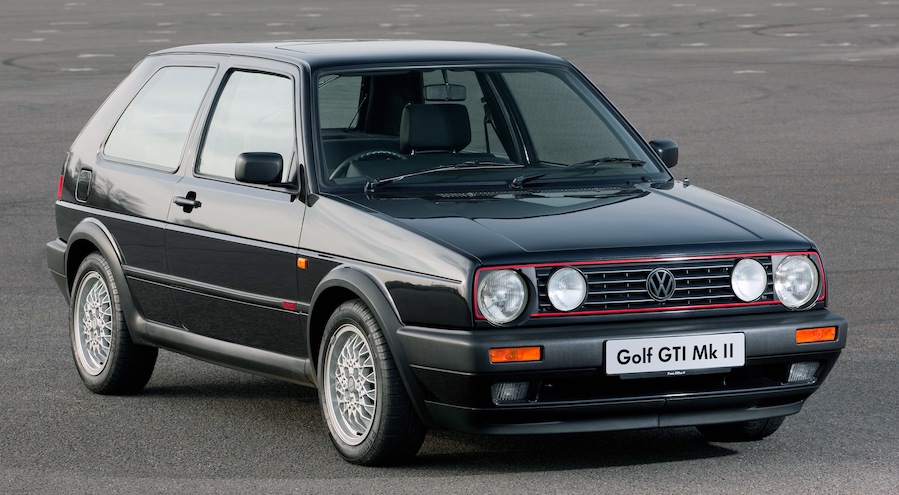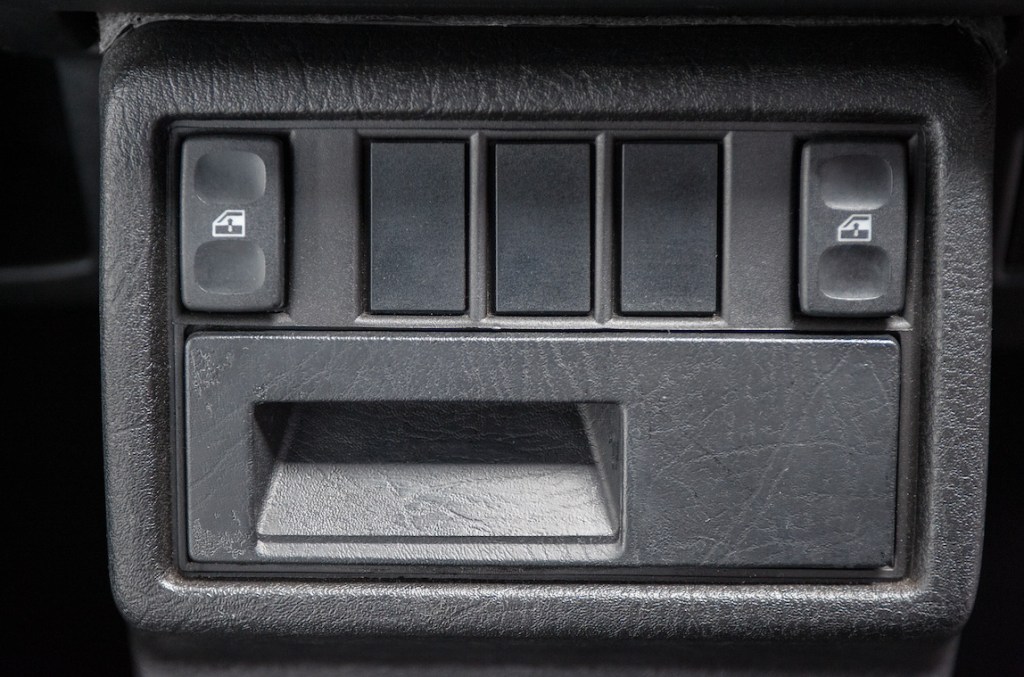While VW Golf GTI Mk2 residual values start to rise, there’s still time to get in on the action. Our comprehensive Mk2 Golf GTI Buying Guide is here to help. However, you need to act quickly in order to find the retro hot hatch of your dreams.
The Mk2 Golf GTI had some pretty big shoes to fill when it was launched back in 1983. While it was slightly larger and heavier than the Mk1 GTI, it still had that vital DNA. Thankfully, it offered the same mix of fun and practicality that made the original Hot Hatch such a smash hit.
While it may have been a financial success for Volkswagen, for quite some time the Mk2 GTI didn’t hold the same kudos as the Mk1. Perhaps this was because it simply wasn’t the ‘original’ hot hatch or it hadn’t been ‘styled by Giugiaro’. Either way, some might argue that these days, it’s actually the better car…

Golf GTI Mk2 prices on the rise
It’s quite astonishing to think that you’ll still occasionally see Mk2 Golf GTIs being daily driven today. Especially when you consider that some early cars are now over 40 years old. While this longevity has been great for some users, it hasn’t suited everybody. The car’s popularity hasn’t been fantastic for those collectors looking to cash-in on their investment. Well, not until recently, at least…
Due to its bomb-proof build quality and huge production run (6.3 million examples were produced in total) the Mk2 Golf was obviously quite popular. It’s also been one of the last modern classics to see residual values significantly rise for these very reasons. Thankfully, as Mk2 GTI numbers finally start to dwindle the car’s cult status has increased, and so have second-hand prices. The fact parts are becoming increasing hard to come by and expensive is the main reason for the rise in value. Well, this and the fact people are finally realising just how good this car is…
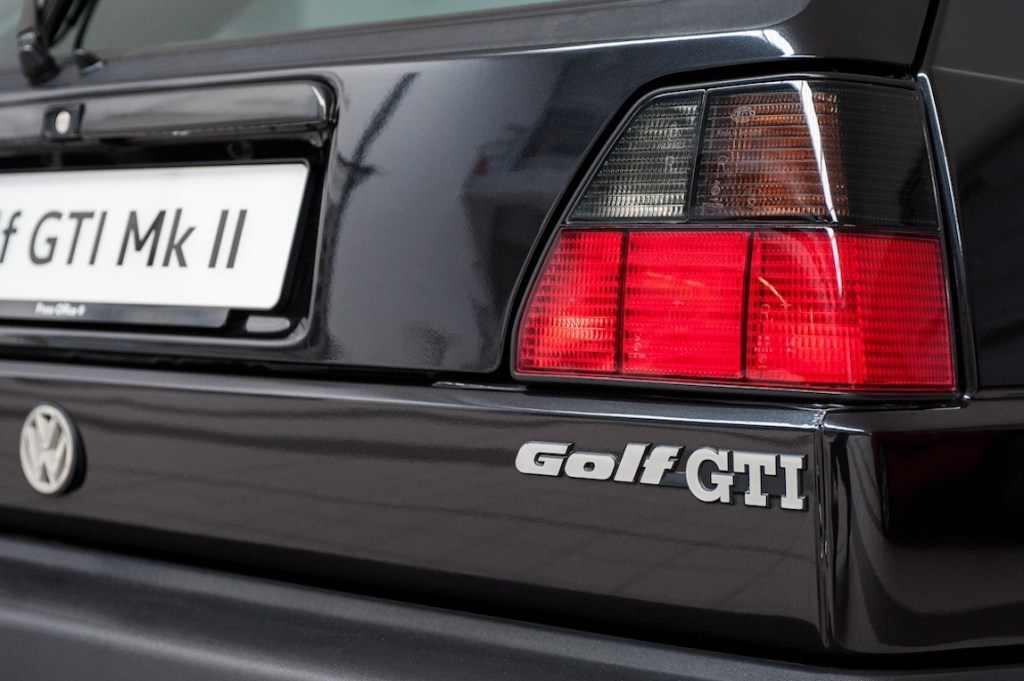
Late-spec ‘big bumper’ cars also came with smoked rear lenses
VW Golf GTI Mk2 Most common problems
- Accident damage. Many of these cars will have been driven ‘enthusiastically’ at some stage of their lives, so check the panel gaps to make sure they line up and look for any odd coloured panels, which might hint at accident damage.
- Roof lining sagging. As many of these cars are approaching 40 years old, one common problem is the original roof linings failing, meaning they may sag or drop down in places. While new material is available to fix this, it’s a quite a tricky job to do.
- Corrosion/rust. While the mechanics on these cars are very robust and easy to repair, rotten shells can be timely and expensive to fix. Look for cars that have been garaged – the less rust you can find the better. Do check sills and behind the GTI arch trims.
Pros and cons
Pros:
- Smiles per mile
- Great investment properties
- Excellent build quality
Cons:
- Be quick – prices are on the up
- Parts becoming harder to find
- Five-door models less desirable

Mk2 Golf GTI History
You may remember the GTI version of the original Golf came much later on in the Mk1 production run. That wasn’t the case with the Mk2 – the GTI model being launched in the same year the car was released – 1983. VW had cracked the ‘sporting Golf’ formula with the Mk1, so wanted to hit the ground running with the Mk2. Well, that’s exactly what it did. There were obvious styling links to its predecessor, albeit with a much bigger, roomier interior and a more mature character. If it ain’t broke, don’t fix it, was clearly the thinking in many respects.
Model timeline
- 1983 (1984 UK) – Mk2 Golf GTI 8v launched
- 1986 – Mk2 Golf GTI 16v launched
- 1987 – Subtle facelift
- 1989 (1990 UK) – Big-bumper facelift (90-spec)
- 1991 – Production ends
In fact, when the car rolled off the production line back in 1983 it featured practically the same engine found in the Mk1 GTI. That right, it was actually powered by an almost identical 1.8-litre 8v engine that was fitted to the run-out Mk1 GTI model. While its 110PS was slightly underwhelming, the excellent chassis meant it was great fun to drive, especially on B-roads.
Come 1985, the 1.8-litre 8v gained hydraulic tappets (which were famous for chatting when the engine is cold). The following year a 137PS (139bhp) 16v was also added to the ‘GTI’ line up in order to keep up with the competition. This car (distinguishably by its bee-sting aerial and 16v badging) was faster, lower, stiffer and higher-revving than the 8v. Naturally, it appealed to those casing numbers, but purist favored the 8v, claiming it was far more fun to drive.
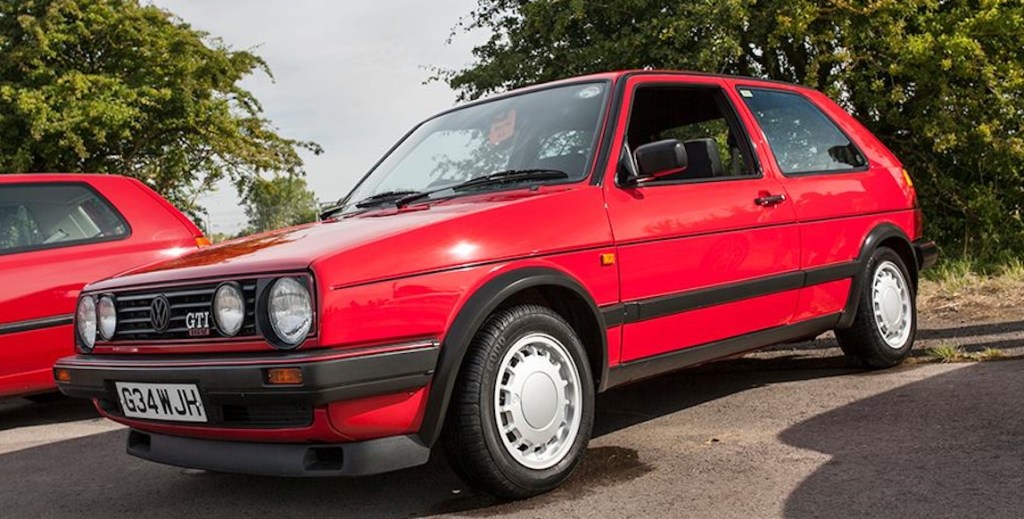
Subtle facelift in 1987 saw quarter lights dropped and five-bar grille added
In 1987 the car received a very subtle facelift (above), which saw the front quarter lights being dropped. The car also had a five-bar grille fitted and some switchgear was changed inside. While many enthusiasts called the pre-87 cars ‘Type 19’, in fact, all Mk2s are technically Type 19s!
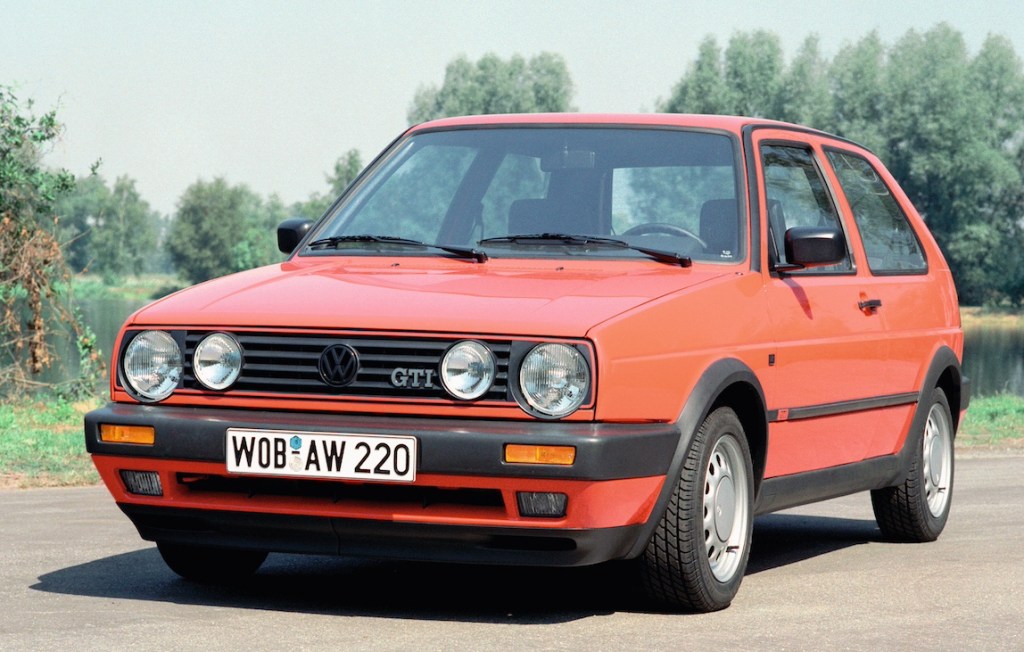
Big bumper car seen here, which also received fog lights, integrated spoilers and smoked rear lenses
Mk2 Golf GTI update
The biggest visual transformation came in 1989, when Volkswagen fitted the car with body-colored ‘big bumpers’ (above). Also added were smoked rear lenses, fog lights and integral spoilers. It wasn’t until 1990 that the car got power steering as standard. The following year the 8v model (which was still available to buy) received the 16v’s suspension and electric windows.
Production of the Mk2 finally ended in 1991 after 6.3 million examples had been made. It was replaced by the Mk3 Golf which was launched on the UK market in early 1992.
Built to last
The reason the Mk2 Golf GTI – and VWs of that generation in general – have been some of the last modern classics to creep up in value is pretty simple – they were built so well in the first place, resulting in numbers remaining high compared to the competition. This is why models such as the Renault 5 GT Turbo, Nova GTE and Peugeot 205 GTI – which all suffered from heavy corrosion – have demanded a premium. When was the last time you saw a Mk2 Vauxhall Astra GTE or MG Montego Turbo out on the open road?
Over engineered
Back in the early 80s, Volkswagen was on a mission to prove it built arguably the most durable cars around, which is why models such as the Mk2 are often referred to as being ‘over engineered’. They were built to last and last they jolly-well did, but thankfully resale values have finally started to soar over the past few years as even basic parts for these iconic cars become harder to source and more costly to buy.

Which VW Golf GTI Mk2 model should you buy?
While the base model Mk2s were great daily cars, they would hardly set your world on fire. This is why the Mk2 Golf GTI model ticked all the boxes, as it was practical and fun, so it was an instant hit. It’s also why the sporty models are demanding a premium these days – even if they don’t feel quite as electric as they perhaps did first time around. Be it the early, small bumper cars or later, big bumper examples, the GTI really is the car to have if you’re after something that’s both reliable and fun. It could well be the ultimate modern classic.
Choosing between an 8v or 16v GTI model (and small or big bumpers) really is down to own personal preference. Three-door cars have always been more desirable over five-door versions and, as a result, still demand a premium. Rare models, such as the GTI G60, Edition One, Rallye and super-exclusive ‘Limited’ have already rocketed on the second-hand market so, unless you’ve got really deep pockets to pay for the unique, hard-to-fine cars, we’d suggest you opt for a clean Mk2 Golf GTI model instead.
The most important thing to remember is that the engines and mechanics on these cars is pretty robust, so rather than worrying about the mileage, you’re far better looking for a car with clean bodywork and a rust free chassis. Cars that have been garaged most of their lives really are the ones to look out for…
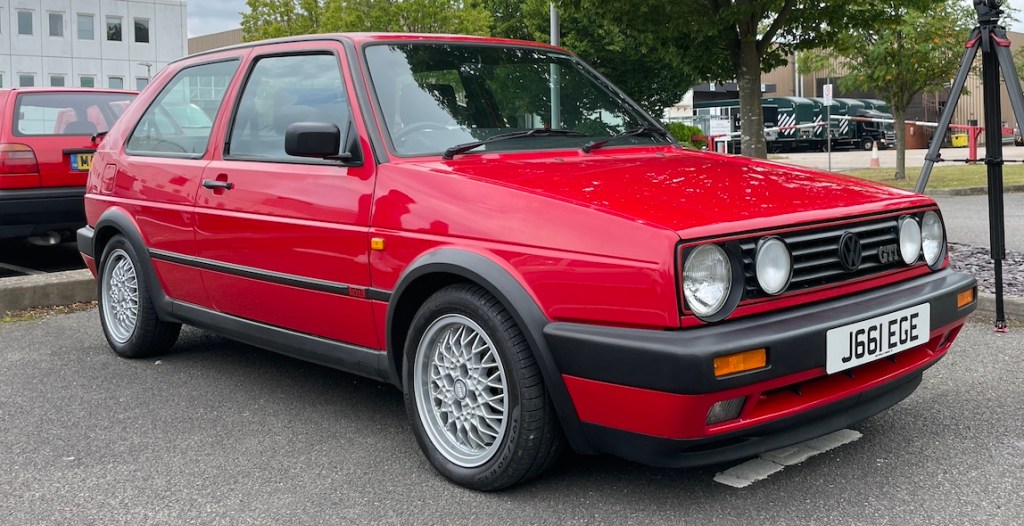
What to look for when buying a VW Golf GTI Mk2
Below, I’ve broken the down into its key areas to help identify any potential problems that you should be aware of, as well as some general information.
Bodywork
The main thing to look out for when viewing any Mk2 Golf GTI is corrosion. While Volkswagen upped its game over the Mk1 where rust was concerned, meaning the Mk2 is much better at fending it off – but it’s by no means immune. So, like we said, it’s important to buy on condition and not mileage.
Thankfully, the original paint itself is very good on these cars. A quick initial walk around the car will soon reveal any differences in paint tones, so check whether all panel colours match and also check the panel gaps to see whether the car has been invoiced in any accidents.
Where corrosion is concerned, the inner wings in particular are a problem area and unfortunately, it’s not something you can realistically check until home, as the plastic liners make it a very difficult task. Shine the torch around the front suspension sub frame to find any areas of rust there. Around the filler cap is another hotspot, plus under the window rubbers. Some modified cars won’t have any arch liners, so with these you’re at least able to check.
More corrosion
Other areas to check include scuttle panel, sills, the bottom of doors and the rear valance – all of which are easy to access. Also, there’s a hidden area to examine for corrosion in the ledge on the bulkhead that supports the brake servo. Dirt and debris can accumulate here, especially if brake fluid has been leaking, which can cause the metal below to rot. If the model you’re eyeing up has a sunroof then the metal surround can often attract rust due to blocked drainage systems, so be sure to double check this, too. Check the door handles all work, too, and the rear hatch lock works.
It’s also wise to check out the quality of any work performed; if it’s obviously noticeable that it’s had a previous shunt of some description, then it’ll need putting right, adding to the overall cost. Mention this when haggling. Although, if you can do this work yourself or know someone who can put it right, it could be a quick win.
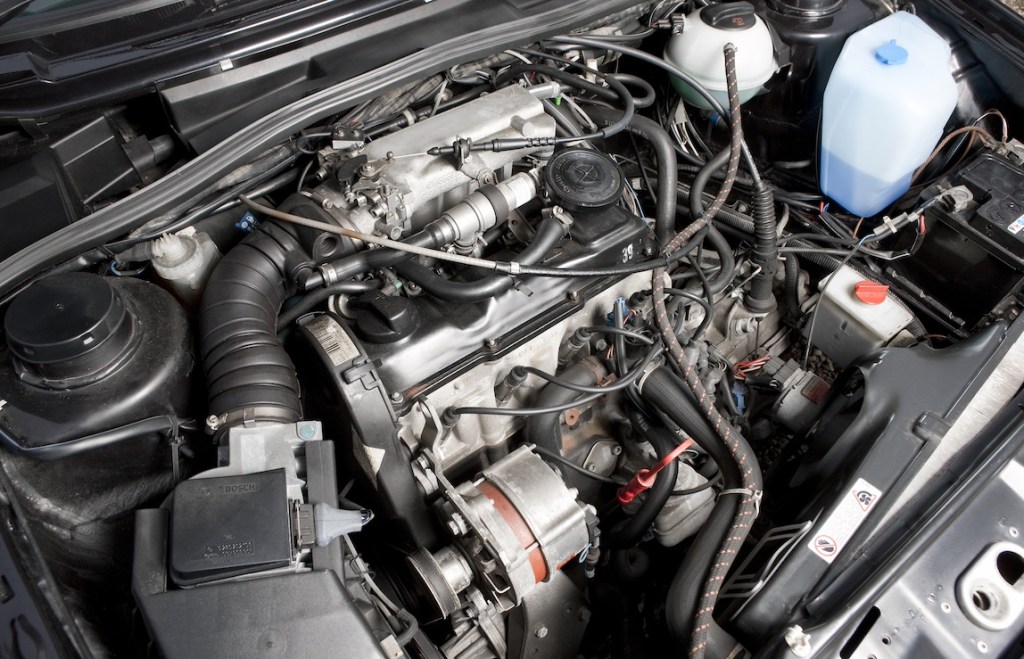
First 1.8-litre 8v engine fitted to Mk2 GTI was almost identical to one found in Mk1 GTI – hydraulic lifters came a little later on
Mk2 Golf GTI Engine
While on paper the Mk2 came with the choice of two engines (8v and 16v), effectively both had the same block and it was just the head that changed. No matter which engine you’re looking at, each unit should last well and worse case scenario, replacements are still easy to find second-hand, if you’re not worried about a matching numbers car.
They are renowned for having a long lifespan, providing they’ve been sufficiently cared for with regular servicing. Always check for oil leaks on these either from the rocker cover or camshaft seals. Also, check inside the header tank cap for any sign of oil emulsifying (mayonnaise like substance), which may mean a blown head gasket.
As with any car, look out for black or blue smoke (check out our guide to exhaust smoke here to help you understand what different types of smoke mean). If you see blue smoke, you could be looking at worn valves or valve stem oil seals. Either way, the result could mean a complete cylinder head rebuild – not a cheap task.
Checks while test driving
Upon test-driving any Mk2 Golf GTI, sit with the engine idling for a while before engaging gear. Listen out for any misfires or the engine simply acting out of the ordinary: erratic movements, strong vibrations etc. If these issues occur, you may just need new ignition components. An uneven idle may hint at a faulty idea control valve. Remember, the ‘tappety’ noise on early cars should go away once the engine warms up and this is perfectly normal.
Often, it’s prudent to have a look on forums and internet auction sites for good condition used ones. If the K-Jetronic injected GTI feels leaden then there may be a problem with an injector. These can be hard to come by new.
If the injector isn’t the issue, it could be a possible leak to one of the vacuum hoses or either a seized metering head or stuck flap to the inside of the air-flow meter. All of these are simple to sort; use them to your advantage when conducting any negotiations. Oh, and always ask when the cam belt was last changed, too, as this needs doing every 25k miles.
You might be surprised to hear the VW Golf GTI Mk2 is actually pretty economical, too, especially the later cars. A well looked after 16v, even driven enthusiastically, could deliver up to 30mpg!
Transmission
The Mk2 Golf GTI five-speed boxes are generally strong and smooth, but watch for loss of synchromesh in second gear and the possibility of differential pins exiting the side. You could have it re-built for a small fee to get them bolted in, if required. Also, fifth gear sits high inside the gearbox casing, so if the oil level drops, the gear can run dry and eventually fail! A sloppy change might hint at worn gear linkage rods, too. Again, second-hand units are still readily available, but we’d suggest a rebuild if you’re going down this route. Some firms still offer reconditioned units on an enhance basis.

Like the Mk1 GTI it replaced, the Mk2 would also lift an inside rear wheel when cornering in anger
Chassis
If you’ve not yet driven a Mk2, you’ll be surprised at just how familiar it is, despite some examples being almost 40 years old. The steering should be precise and the seating should be firm, with a firm ride yet not one of discomfort. It should feel solid and planted on the road.
Be aware that with early Golf Mk2 models the power steering was optional at the time; a lot of buyers decided not to spend the extra £567 and went without, so a lot of the early Mk2s on the road don’t have it. Not a deal breaker but it may put you off if you do a fair bit of urban driving.
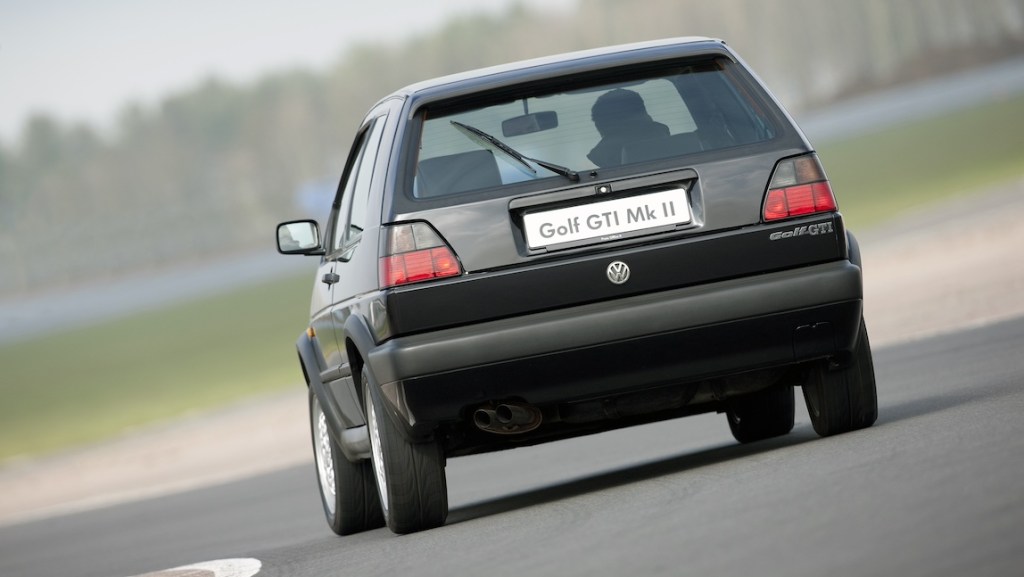
Mk2 Golf GTIs came with adjustable camber for the front suspension, which could lead to front tyres with uneven wear. Look out for leaking dampers and warn (knocking) top mounts. Also, tread carefully when buying any modified example. If it has previously run – or is running – coilover suspension you don’t know if, or how long, the car been run on the bump stops, or even if it was driven with them in at all. You may find a well-looked after one in the modifying scene, however, and taking the modifications off to put it back to stock shouldn’t be too difficult a task.

15″ BBS wheels were an optional extra that many simply couldn’t refuse
The VW Golf GTI Mk2 brakes are generally pretty good with discs (vented on the 16v) all round. Replacement discs and pads are readily available. We’d actually recommend a decent performance disc and pad upgrade if yours need changing as they will look identical but offer improved stopping power. The rear calipers can be prone to seizing, which usually means you simply need your rear brakes are worn.
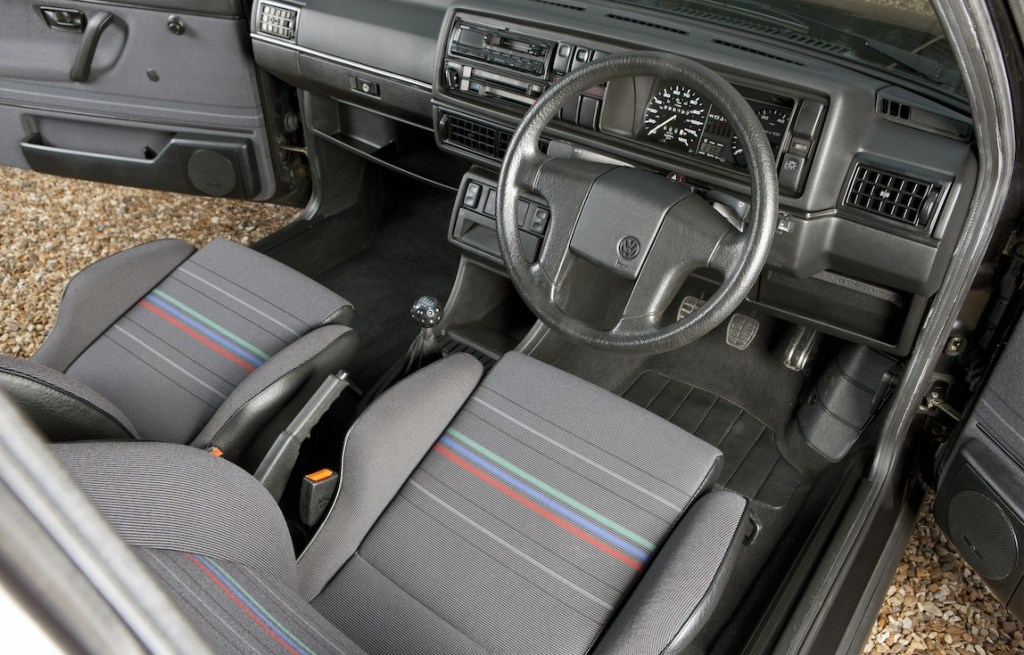
Interior
While interiors won’t set your world on fire in terms of design, they are equally as robust as the engines. That being said, forty-year-old plastic trims have become fragile over the years. Try to avoid cars with sagging roof linings, cracked dashboards and seats with too many rips, unless you’re looking at a project. eBay is still full of second-hand parts for these, while Heritage Parts Centre offers plenty of new replacement options – even interior material!
How much should you pay for a VW Golf GTI Mk2?
Trying to find an unmolested car that hasn’t been modified is very hard these days. We’ve heard stories of people spending a fortune putting their modified Mk2 Golf GTIs back to standard to increase collectability and value. In terms of what to pay, it’s really hard to say. There are still plenty of projects around from £2000 upwards. Although we’ve seen high-end cars go for silly money, especially in America. Below is a very rough scale of what to pay. But, a lot comes down to the exact spec and condition of the individual car in question.
- £2000+ Project (Will usually need welding, some paint and a number of mechanical sorting)
- £5000+ Clean (A solid, running car that’s far from perfect, but could be with time and money thrown at it)
- £10000+ Very good (A great looking car that may have high-mileage but has been looked after but is solid)
- £15000+ Excellent (Usually cars that have low miles, great history, matching numbers and have been garaged)
- £25000+ Concours (These are your best-of-the-best, trophy winning, could-eat-your-dinner-off-them cars)
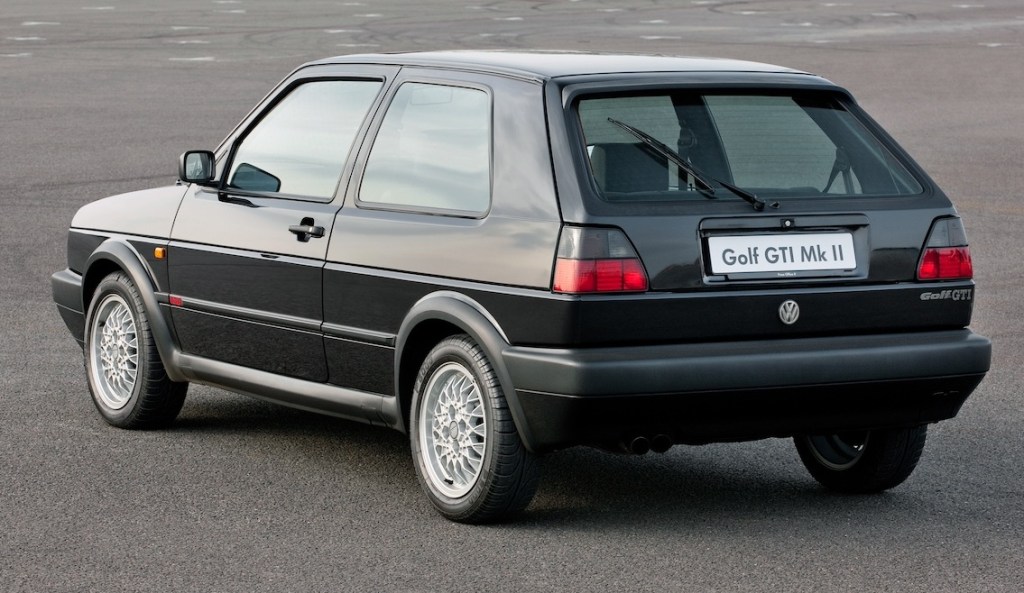
If you love German cars, be sure to check out our German Car Festival event at Goodwood! Check out our event preview here, or head over to the event website for tickets and more info.

